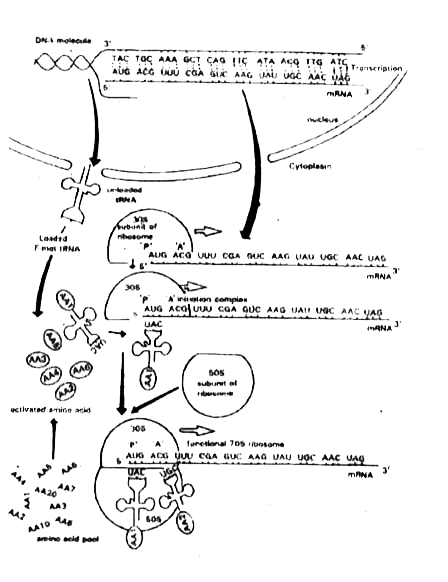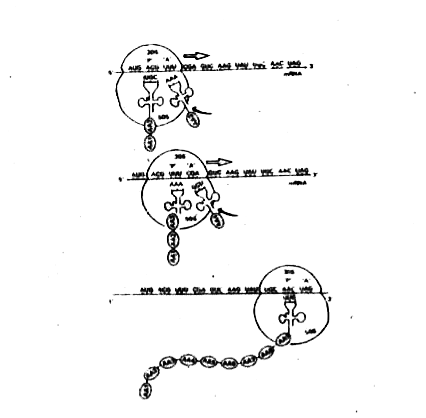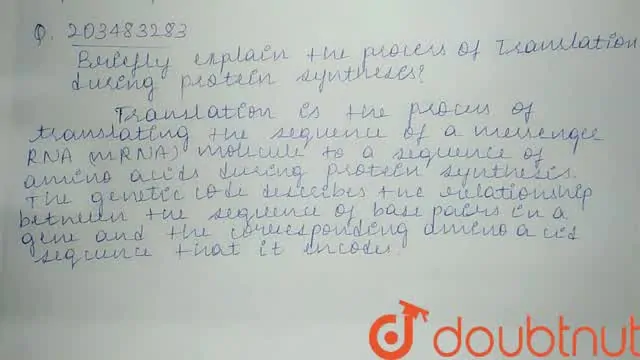Briefly explain the process of Translation during protein synthesis? Solution in Kannada
Translation is the second step during protein synthesis in which using genetic information on mRNA in nucleotide language, protein synthesis takes place on the ribosome in the amino acid lineage. mRNA carrying coded message for the synthesis of protein will be released into cytoplasm. With the help of this mRNA translation occurs in four steps.
They are (1) Activation and selection of Amino acids (2) Chain initiation (3) Chain elongation (4) Chain termination.
1. Activation and selection of amino acids: In this step, an 90 acid combines with ATP in the presence of amino acid synthetase and forms activated amino acid and this process is known as activation. The activated amino acid thus will be picked up by specific +RNA molecule and form amino acid +RNA.
Amino acid + ATP to Activated amino acid Activated amino acid
+ +RNA - Amino acid +RNA
2. Chain initiation: During this process, initially mRNA attaches to smaller ribosomal subunit! Then +RNA carrying methionine attaches to the initiator codon (AUG) of mRNA. Now larger ribosomal subunit attaches to mRNA, such that the +RNA with amino acid coincides at P-Site. Soon after this, another +RNA with a second amino acid attaches to A-site peptide bond is formed between the first amino acid occupying A-site. Chain initiation needs ATP and proteins called initiation factors.
3. Chain elongation: Soon after chain initiation, ribosomal subunits slide along mRNA. This shifts the +RNA occupying A-site automatically to the P-site. Now to the emptied A-site +RNA carrying third amino acid gets attached With this peptide bond is established between second and third amino acids. This results in the growing of polypeptide chain referred to as chain elongation Chain elongation requires GTP. elongation factors and Mg+2ions.
4. Chain termination:
As soon as the sliding ribosomal subunits arrive at the terminator codons, the protein synthesis is stopped with the association of releasing factors to the larger subunit of ribosome. This is known as chain termination.
Soon after chain termination, newly formed polypeptide chain undergoes processing and attains specific structure.


Related Playlists
- BOOK - SUBHASH PUBLICATIONCHAPTER - MOLECULAR BASIS OF INHERITANCEEXERCISE - THREE MARKS QUESTION2videos
MOLECULAR BASIS OF INHERITANCE
- BOOK - SUBHASH PUBLICATIONCHAPTER - MODEL QUESTION PAPER 3EXERCISE - PART -D10videos
MODEL QUESTION PAPER 3
- BOOK - SUBHASH PUBLICATIONCHAPTER - ORGANISMS AND POPULATIONS EXERCISE - FIVE MARK QUESTION AND ANSWER6videos
ORGANISMS AND POPULATIONS
Similar Questions
How is nucleosome formed? Draw a diagram of the nucleosome.
05:17View SolutionDraw a neat diagrammatic view of the male reproductive system.
02:01View SolutionWhat are adaptations ? Discess any four adaptations found in plants and animals.
View Solutionजीन तथा प्रोटीन-संश्लेषण में क्या सम्बन्ध है? संक्षेप में समझाइये।
View SolutionThe translation step in the process of protein synthesis is made by a charged form of
01:33View SolutionGive the centrol dogma of protein synthesis. Explain the process of translation.
08:11View SolutionRNA synthesis: _______________ :: Protein synthesis: Translation
39:56View Solutionप्रोटीन-संश्लेषण प्रक्रिया को संक्षेप में समझाएँ |
01:45View SolutionExplain the process of translation in protein synthesis.
43:12View SolutionTranslation |Protein Synthesis#!#Part 1
03:12View Solutionপ্রোটিন সংশ্লেষের সময়ে DNA থেকে mRNA সংশ্লেষ হওয়ার প্রক্রিয়াকে কী বলে ?
06:37View SolutionTranslation|Protein Synthesis
05:25View Solutionयूकैरियोटिक hn RNA की प्रक्रिया में प्रोटीन संश्लेषण के दौरान टेलिंग की प्रक्रिया में सम्मिलित होता है
03:46View SolutionExplain the process of translation for synthesis of proteins.
00:45View SolutionExplain in brief the process of initiation during protein synthesis.
02:20View Solution


